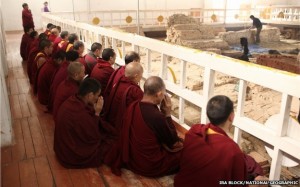In a paper published by the Antiquity Journal (on November 25th, 2013) archaeologists reported uncovering the “earliest ever Buddhist shrine” while digging at Buddha’s birthplace. The archeologists led by a team from Scottish Universities Environmental Research Centre and Durham University unearthed a 6th Century BC timber structure buried within the Maya Devi Temple at Lumbini in Nepal. The shrine appears to have housed a tree. Buddhist tradition records that Queen Maya Devi gave birth to the Buddha while grasping the branch of a tree within the Lumbini Garden.
Every year thousands of Buddhists make a holy pilgrimage to Lumbini – long identified as the birthplace of Siddhartha Gautama, who became the Buddha. Yet despite many books and texts chronicling his life and teachings, it is still uncertain when Buddha lived. Several estimates for his birth dates his life back to 623 BC, but many scholars believed before 390 BC to be a more realistic time frame. Until now, the earliest evidence of Buddhist structures at Lumbini dated no earlier than the 3rd Century BC, in the era of the emperor Asoka.
Archeologists uncovered a wooden structure with a central void which had no roof. Brick temples built later above the timber were also arranged around this central space. To date the buildings, fragments of charcoal and grains of sand were tested using a combination of carbon-dating and optically stimulated luminescence techniques.
“Recent UNESCO-sponsored work at the major Buddhist centre of Lumbini in Nepal has sought to overcome these limitations, providing direct archaeological evidence of the nature of an early Buddhist shrine and a secure chronology. The excavations revealed a sequence of early structures preceding the major rebuilding by Asoka during the third century BC. The sequence of durable brick architecture supplanting non-durable timber was foreseen by British prehistorian Stuart Piggott when he was stationed in India over 70 years ago. Lumbini provides a rare and valuable insight into the structure and character of the earliest Buddhist shrines.” – The team stated in their report.
The discovery which was supported by the National Geographic Society could aid conservation efforts at the site which has been neglected despite its UNESCO World Heritage status and the recent efforts that have brought more attention to Lumbini.
















